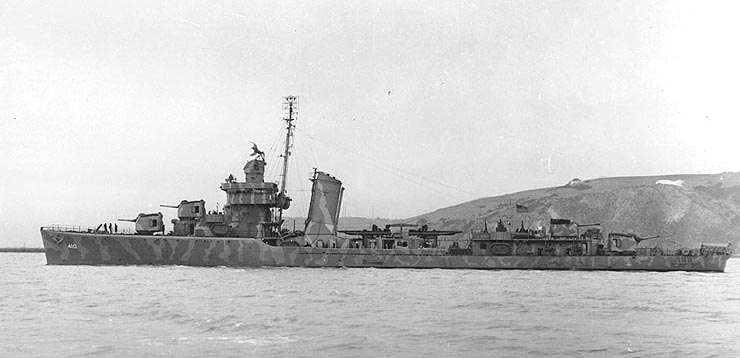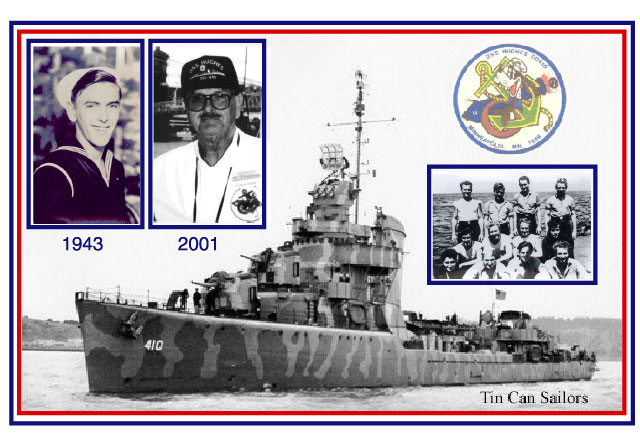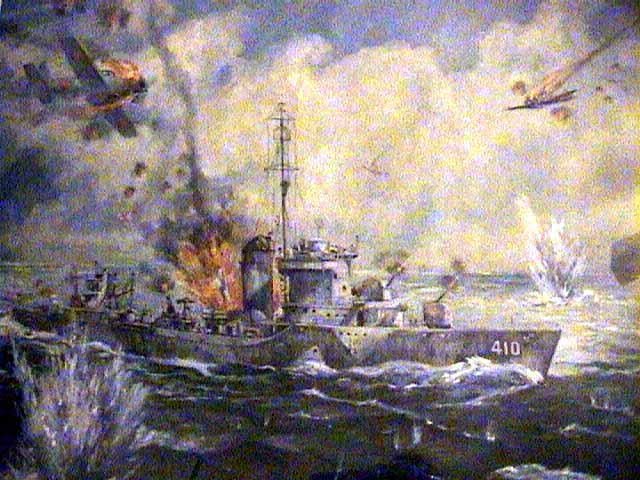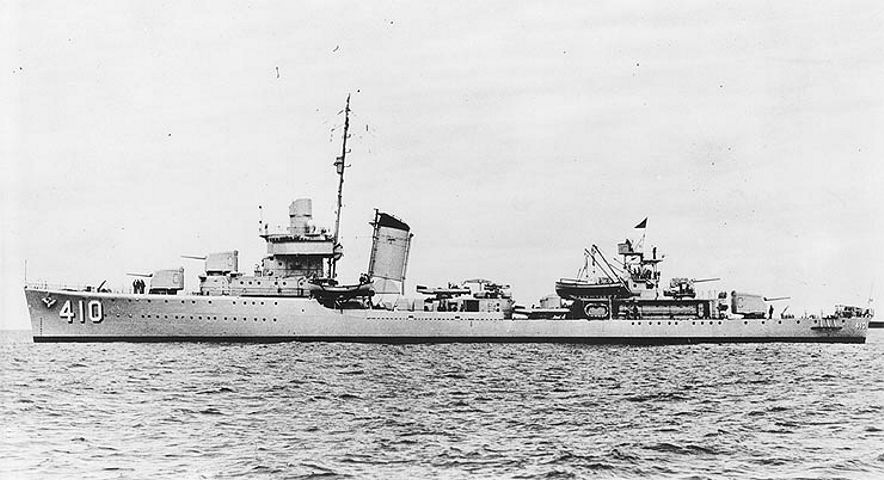

USS Hughes (DD-410)
But to get back to the day at hand. We had just
finished the Ormoc Bay landing, and were now anchored in Leyte Gulf.
We had been the flagship for the operation under the flag of Rear Admiral
Struble. Although the day was spent in taking on provisions and ammunition,
it seemed like a busman’s holiday not being in some hot action for a change.
However, as in any hot war, a day of rest has to end
sometime, and for us it ended about 1400 when we were to depart for our
picket station off of the island of Dinagat. Normally picket duty
is considered routine and none of the ships crews cared for the duty.
The ships selected for picket duty would just cruise around the area trying
to pick up enemy planes on their radar screens that cold not be detected
by the land-based radar due to the mountainous terrain.
We were to relieve another destroyer that was on picket
duty in the Dinagat area at 1700 that day. However we never saw the
other ship. We arrived on station at 1650 and the skipper was giving
us a rundown on what to look for and since some of these islands were no
more than mountains jutting out of the sea, we were told that the radar
would be ineffective in some areas.
While the skipper was passing the word over the P.A.
system, another voice was heard in the background informing him that a
flight of ten bogies (enemy planes) had been picked up on radar.
No sooner had the word come over the loudspeaker than the General Quarters
alarm was sounded. I was working the mid-shift in the radio room that
week and decided I would sleep through chow. I lay in the sack listening
to the voices coming through the speaker and as soon as I heard the alarm
I jumped up. I was fully clothed except for my shoes so I slipped
them on, not bothering to tie them. My bunk was forward of the mess
hall and galley near the bow of the ship and my battle station was on the
twin-mount 40-mm guns just aft of midships. I rushed through the
mess hall and up the ladder to the main deck leading aft. I was third
loader for my gun position.
All hell seemed to break loose. All the 5” 38-caliber
guns were firing simultaneously and the 20-mm and 40-mm guns were chattering
like a cage of excited monkeys.
The enemy planes were circling just out of range of
our weapons and probably deciding who would be the first to die for his
glorious Emperor. Suddenly one of the planes broke formation and
was approaching the Hughes from our starboard side where he intended to
crash into us. However the hail of fire was so great that he swung
in a circular motion around the stern of the ship and was coming in on
our port side now.
All guns were trained on this lone challenger and
tracers could be seen flying all around him. At last we could see
that plane’s engine was on fire. We had scored a hit!
Everyone was excited and thought surely the plane
would either explode or crash into the water. But no, although the
plane was burning fiercely, the plane was still heading in a death dive
for our ship. We tried evasive action but to no avail.
The plane crashed into our port side midships, gouging
a huge hole in the side and main deck. The plane’s engine continued
down into the engine-room where a tremendous explosion shook the destroyer.
The water continued to pour in the hole in our side.
A large spool of 5” line had been hurled through the air and landed on
the bridge, starting fires there. It seemed the Hughes was doomed.
Badly listing from all the water that was pouring into her bowels, it must
have appeared to the remaining nine bogies that they would not be needed
to finish us off.
All power was knocked out when the boilers in the
engine-room exploded. Using his megaphone, the skipper informed all
hands that we were not to fire any guns at the remaining planes so that
they would think we were finished. However, at the precise
moment he was talking, one of the crewmen on 5” gun #1, due to the excitement,
kicked out a round at the circling planes (although we had no power, the
guns could still be fired manually). It was pitifully short of the
target and only seemed to infuriate the enemy planes into further action.
A second plane peeled off from the formation and headed
for our ship. Everyone was waiting tensely by their guns for
the plane to come into range. They knew that they would have
only one chance to knock him out of the skies before he would be on us.
Just when we thought it would all be over, a flight
of four of the most beautiful P-38’s came to our rescue. One of the
men on duty in the radio room had manned a battery-operated radio that
had been left aboard from the Ormac Bay landing and had sent out a distress
call. The P-38’s were on patrol duty and had picked up the call and
had come to our aid.
As soon as the bogie spotted the P-38’s bearing down
on him, he turned and fled back to his formation. With the P-38’s
still in hot pursuit, the enemy planes disappeared over the mountains and
were not seen again by us. It was later reported that the planes
had flown over Leyte Gulf and some of them were shot down while others
crashed into the big merchant ships at anchor there.
By this time a drizzling rain and fog had closed in
on us. We were all wet and miserable but glad to be alive.
Everyone had calmed down by this time (to some extent) and an assessment
was made of the damage. One thing was certain—we would not make Leyte
Gulf under our own power.
About 2000 we received word that help was on the way.
The sea-going tug QUAPAW, was sent out to tow us back to safety.
A cruiser and two destroyers were sent along to see that we were not attacked
again.
At 2200 the tug arrived and lines were secured to
our ship and once again we were underway. We arrived in Leyte Gulf
the next day and work was begun immediately to repair the damaged ship.
The dead and wounded were transferred to a hospital ship. A final
count showed eighteen dead and 40 wounded.
The Hughes was slowly put together as well as possible
and a huge Army generator was set up on the main deck to use for power.
Just before Christmas we made a trial run around the Gulf and found that
the ship could make a top speed of about 18 knots.
We left Leyte in company with the Cruiser Canberra
for Noumea, New Caledonia. Upon arrival, we had more extensive repairs
made and then sailed for Pearl Harbor, once again in company with the Canberra.
During the trip we encountered rough seas that split
the seams of the ship where it had been temporarily welded. It seemed
that the Hughes was just destined not to reach Pearl. However, we
fell in behind the Canberra and followed in her wake. This seemed
to help, and finally we reached Pearl.
We spent a few days at Pearl before continuing on
our trip to San Francisco where we would enter drydock for a complete overhaul.
One amusing thing happened while at Pearl. Our ship was at anchor
and the crew was just lounging around on the decks. One man was asleep
on the torpedo deck. A low-flying plane buzzed our ship to inspect
the damage, presumably, and the sleeping crewman, thinking we were under
attack again, rolled off the torpedo deck breaking his arm.
The skipper requested that no other planes buzz our ship because the crew
was still a little leary of any planes flying too close to us.
The Hughes departed Oahu unaccompanied, as the Canberra
was headed for the East Coast through the Panama Canal. The trip
was slow and uneventful until we reached the waters outside of San Francisco.
We were flying our homeward bound pennant after many months of continuous
fighting in the Pacific. We had been away from the States thirteen
months on this trip and a lot of action had been seen from the Marshall
Islands in the Central Pacific to the Philippines.
Our luck ran out once more as we neared the Golden
Gate Bridge. The steering mechanism went out and the Hughes
once again had to call for help. We were towed into Hunter’s
Point Naval Drydock where we were to spend the next five months on a complete
overhaul.
Upon completion of our shipyard availability, we were
assigned to the North Pacific Fleet. Since so many new destroyers
had been built since the beginning of the war, the Hughes was now classified
as an outdated ship. We were to be used on bombarding missions in
the Kurile Islands and to hunt out Jap fishing fleets in the Sea of Okhotsk
off Sakhalin and sink them. This continued until the end of the war.
Since the Hughes had served through so many of the
major engagements in the Pacific War, it was only fitting that she be selected
to be in on the unconditional surrender signing that took place in Ominato
Bay aboard the U.S.S. Panamint at the same time the signing took place
in Tokyo Bay aboard the Might Mo (U.S.S. Missouri).
This still does not end the story of a glorious fighting
ship. During the Bikini atomic blast, the Hughes was to ride
out this last bit of action as a ship in the target area. However,
the Hughes survived and was towed to the Bremerton, Washington shipyards.
I have often wondered what happened to the Hughes
since then and often think of that dismal day in December 1944 when I lost
some of my best friends. It’s been over 21 years now but that
day is as fresh in my memory as if it were yesterday.
He was very proud when he told me this. I never
knew if it was legend or truth, but to me it doesn’t matter. It was
what my father believed. And it’s what I want to believe, too.
Robert Louis Swan



Afterword

